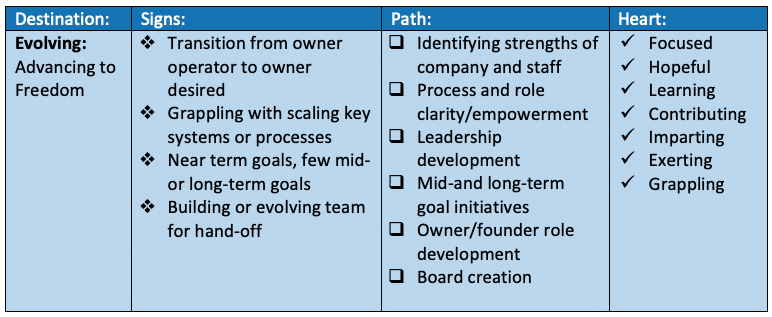Increasing value and scalability
In our first blog, we introduced a new map to help identify where your company is and a path to more quickly get where you want to go. By way of review, the map identified six destinations of companies from Start Up to Legacy. These six are: Planting, Drowning, Grinding, Scattering, Evolving, and Transcending.
The Evolving Stage is the fifth destination we are unfolding in more detail. As before we will identify each destination’s signs, paths, obstacles, and states of heart. At a 30,000-foot view, below is what the destination of Evolving looks like:

Now, we will drill down into “Evolving” to help it come to life.
Evolving: The Signs and the Paths
The Evolving Stage is often the stage that entrepreneurial companies dream of reaching. When entering this stage, a high level of success already has been achieved—and multiple short or near-term goals have been celebrated. But Evolving has a much sharper focus on creating longer-term outcomes. It is a stage where questions emerge—such as, “Is this enough?” and/or “What does the next stage of the company, and its mission, look like?”
Evolving can be a tricky and challenging destination as many of the traits that helped the company get off the ground can be the things that hold the company back. Whether you personally want to move toward a new freedom to dream, to try new endeavors, or to experience release from a stressful workload, there is now a distinct set of challenges and opportunities to explore. This can be a time of hope, discovery, and preparation that will place you on a path to your next destination.
John F. Kennedy had a fitting quote that reflects on focusing forward. “Change is the law of life and those who look only to the past or present are certain to miss the future.” Change is inevitable. What will it look like for you and your company?
Evolving has its roots in a desire to move beyond “getting by.”
The word, “evolve” means to develop gradually…from simple to complex, to unfold, progress, or to develop. Most owners eventually want to move out of “operating,” or “keeping the ball rolling,” so that they can enter into a new season of “owning.” Often, after having a season of success, the scales start to tip towards the rewards of more family time and recreation. Also, thoughts of contributing to a greater good might be circling in your mind. You may feel the desire to impart your hard-learned lessons to others on a similar journey.
The Evolving Stage is the destination where you can focus on a better way—forging a new path that will strengthen your expertise, and improve processes for the journey ahead. How can you know for sure if you are heading for, or are living in “Evolving?” The following obstacles and real-life client stories can help identify where you are on the path.
Obstacle 1: “There is not enough time.”
“There seems like there is too much to do,” said every owner and employee during both good times and hard times. A great deal of energy has been exerted in doing multiple tasks and projects to ensure the company’s growth. In the beginning of the business, much of the effort comes from the original founders. While this is critical, it can also become a trap.
Time Trap Symptoms:
One major obstacles seen in the Evolving Stage is the “time trap.” A key characteristic is finding yourself stuck in the middle of most, or all decision-making. Many times throughout the day you may think, “I have so much to do, and I don’t know where to start.” You might feel pressure that “EVERYthing needs to reach completion, and that EVERYthing requires my attention and skill.
Decision Fatigue
This struggle with on-going problems can bring about “Decision Fatigue,” which is a mental and emotional fatigue serious enough to impede good decision-making. You may notice 4 main symptoms of this overload: procrastination, impulsivity, avoidance, and indecision.
Helicopter Leadership
Another indication that the company is in the “time trap” is “Helicopter Leadership.” The owner/operator jumps in-and-out of projects—in hopes of quickly providing instruction, advice, or support. Often, just the opposite happens. The repeated hovering and landing creates false starts, and/or restarts that, in turn, clouds communication, and causes delays. Staff who have had the lead on an item, or issue, can feel their efforts become undervalued—which can lead to becoming de-motivated.
Awareness is the first step
One company we helped was experiencing both of the “time trap” symptoms noted above. The business had a visionary owner who liked to focus on many initiatives at the same time. One of the challenges that emerged was the same owner was a part of each initiative. In his desire to help and guide, he became the gate for every decision.
At the same time, this owner wanted to be freed up and spend more time with family. This founder’s goal was to become an “owner” versus an “owner/operator.”
A second challenge was the staff was feeling stymied. They wanted to help, but felt they were not empowered to “own” processes and decisions.
A first step towards resolving this was to have the owner realize the trap. The second was to start to discuss ways to let the staff “own” the processes. We also identified the need for an “integrator” that could help filter through all the visionary owner’s ideas—by selecting and prioritizing initiatives and work with the functional leaders to build real time lines and accountability. Overall, outcomes (and accountability) were very low because the owner helicoptered in-and-out based on a very busy schedule. The owner’s leadership was ineffective—and so important issues and development were dropped. Staff motivation dropped, as well.
Obstacle 2: “The staff is not ready.”
Another obstacle often discussed in or on the way to the Evolving Stage is the Depth Trap. When encountering this obstacle, the owner/operator feels like there is not an opportunity to step back from the day-to-day operations. Several reasons might be the root cause.
Often, a company does not have the financial resources to hire experienced resources in the beginning stages. Those that are hired are commonly brought in to focus on and offload tasks. While this can tactically make sense, and does result in freeing up over-strapped resources, it can become a trap. Having the right staff, with the right knowledge, depth, and capabilities is a key to evolving the business.
Depth Trap Symptoms:
The first symptom is that there are no effective plans to transfer knowledge or skills. Without a mentoring process, new or less experienced staff might not be able to grow and grasp new systems. This quote from Benjamin Franklin may offer an antidote to this important concern of the depth of experience in staff. “Tell me and I hear. Teach me and I remember. Involve me and I learn.”
Write it down
A second symptom is that the knowledge and information needed to run the company is not documented, it is only in the founder’s, or a few people’s heads. Without enough accurate instruction and documentation, having a scalable or repeatable process is elusive. Without it, the staff does not have a way to see or grasp key processes.
A Path To Grow
A third symptom in this area is a lack of a path for career development. Often there are no plans for individual growth and advancement.
It has been said that people make the culture and leadership crafts the culture. One client we worked with was very focused on company growth. Being the first and best salesperson the company had, this founder was always involved in initiatives and deals.
The owner identified the biggest challenge in their current phase was that no one was available to vet and run with the key initiatives. There was an on-going struggle and strain to not be in the middle of every decision. Most items were not important enough to reach the high-level owner or CEO level, so too much time was spent grappling—instead of mentoring, capturing key principles, or delegating. As a result, staff was not developed, empowered, or motivated. The turnover was high.
The operator/owner was too busy and not able to be productive. Moving from this state is a process, one that the owner acknowledged. The starting point was to understand both the capabilities, as well as the strengths the company needed. The second step was to determine what gaps there were and how to fill them. One strategy used was to leverage experienced resources that could not only identify the challenges, but could play a role to help fill the gaps. This took the form of fractional leaders in the interim to help mentor and develop staff.
Obstacle 3: “Planning to plan.”
A third obstacle to the Evolving Stage is the Planning Trap. The action of planning eventually emerges as an important thing, but how, and when to do it, can be a challenge. Just the action of scheduling time to plan, plus making it part of the culture, is difficult because of competing day-to-day demands.
“Long-term planning is often undervalued by our indefinite short-term world,” said German billionaire entrepreneur and co-founder of PayPal, Peter Thiel. It is too easy to focus so much on the short term that we never open the lens to the bigger picture. Often, when we take a broader view, what we need to do becomes more apparent.
Another famous entrepreneur, Jim Rohn, whose mantra was “improve yourself everyday,” sums up the necessity for strategic planning: “We all need lots of powerful long-range goals to help us past the short-term obstacles…Remember that all success is based on long-term commitment, faith, discipline, attitude and a few stepping stones along the way.”
Planning Trap Symptoms:
One symptom that you may be in this trap is if the phrase, “we were planning to get to that,” is commonly said in meetings. You’ve heard, “If you fail to plan, you plan to fail.” If little-to-no planning is taking place, or if there is only tactical and short-term planning, you will most likely trip up here.
Another symptom would be that planning is not part of a cycle for your company. You can’t put a plan in action until you have put a plan in place. If you don’t have a regular cycle you can point to, this can be a strong sign you are merely “planning to plan.”
A third symptom may not be so obvious. There may be a specific time set, and even a method selected, but you don’t seem to reach strategic or productive discussions. If the time spent in these areas becomes more of a “report out,” or a “check the box,” it may be time to take a step back and see if there is a better approach. Too often the results of these meetings is that nothing moves forward. Communication and decision-making attempts proved ineffective.
Obstacle 4: “What is my role?”
A fourth obstacle in the Evolving Stage is the “My Role” Trap. One of the hardest challenges for a company moving from surviving to evolving is “letting go.” As noted earlier, this can be tricky, because the things that made it possible to get to this point are likely not the same things that will take your company to the next stage.
Best-selling author James Clear writes in Atomic Habits, “With outcome-based habits, the focus is on what you want to achieve. With identity-based habits, the focus is on who you wish to become.” As the original founder, your skills and abilities were critical to the company, but that can develop into a trap if you are not careful.
“My Role” Trap Symptoms:
Are you suited to take the company where you want to go? In some cases, your skills will be what is needed to go to the next level. In other cases, evolving is a time to leverage others that may have a different skill set and experience.
One sign that you may be in the “my role” trap is if you often feel indecisive in this area. Your emotions will tend to ebb and flow causing frustration and uncertainty.
A second symptom is that a clear path forward is obscured by analysis paralysis. If you do not have a clear vision or path, it may be a signal to involve others that are not so close to the situation, so that they can engage and help identify gaps or blind spots.
One business we worked with had made the decision to be out of the day-to-day operations. They had started to build a team for the future and engaged a Board to help provide feedback. These are all good steps in the journey of evolving.
But this owner had much of their identity in their business. Wanting to let go (but also wanting to still be involved) became a difficult dance for the owner, the new team, and the Board. A great deal of the new team’s time became involved in reporting, and taking deep dives into various processes. Progress and team motivation began to wane.
Ultimately, due to not creating a distinct role and separation, the owner decided to return to the business.
Impacts of the Obstacles and Traps:
Each of these obstacles and subsequent traps towards the Evolving Stage can significantly slow down the company’s growth. Not only can the company’s growth stall, but staff development can remain stagnant, as well.
Without a clear path, the company and staff often feel “stuck.” Important decision-making is being deferred, or worse yet, not happening at all. It is like when the ability, agility, and acuity of a rock climber reaches capacity at the halfway point. The exhausted mountaineer is forced to stop for recovery and reassessment. There can be no advancement without rest, appropriate tools, encouragement, and support from others to make good decisions.
Paths to move from idea to results:
- Identify the strengths and roles of each leader. What kind of roles will be necessary to grow the company in 3-5 years and beyond? Who is best to scale the company? If not the founder/owner, then who? Does the team have the skills necessary for continuous transformation?
- Leverage staff strengths. Help each employee reach their potential by assessing their skills and abilities. Does each leader have the emotional and mental acuity required for excellent inter-and intrapersonal communication? Does the team collaborate and cooperate easily, instead of compete with one another? If not, why not? Who else needs to join the team to help it grow stronger and more synergistic?
- Develop mid-and long-term goal initiatives and plan an exit strategy. What are some risks and benefits of an outright sale, hand-off, or intergenerational succession?
- Establish a planning and review process that includes at its core…a clear mission and vision. Spend some time dreaming about possibilities and build some excitement.
- Establish an outside Board to provide advice, insight, and shared thinking. Decide on the purpose for the Board and its mission. Fill the seats of the Board with experience and varied perspectives. The business consultant and author of the best-selling One Minute Manager, Ken Blanchard, explained its importance this way: “None of us is as smart as all of us.”
“Evolving” Stage Success:
The big-picture view is that a diligent owner’s time is spent acquiring a sharp focus on strategic vision, planning, and leadership development for the future. Personally—emotional and physiological feelings of “letting go…” have gradually evolved to “trust.”
Roles are Defined
The step of defining a clear role and purpose for the founder is in place. If there are gaps and needs to reach the next level, a transition plan has been established, so that there is confidence and conviction for the owner and/or leadership team to advance forward to achieve new heights.
The Right People, The Right Seat
Appropriate efforts have ensured that the right people are in the right seats, playing to their strengths. John C. Maxwell writes in his book, How Successful People Think, “the wrong person can give you problems instead of potential; the wrong place can give frustration instead of fulfillment; and the wrong plan, grief instead of growth.” He developed the following formula for building a formidable core of leaders: “The right thought, plus the right people in the right environment at the right time for the right reason, equals the right result.”
The Path is Clear
The owner and all leaders can describe a straightforward, unambiguous, and clear path ahead. Esteem, and self-actualization, the top 2 rungs of Maslow’s Hierarchy of Needs, are within sight. Individuals have transformed from meeting basic needs—to acquiring respect, self-esteem, status, recognition, and freedom. All leaders feel empowered and free to contribute in meaningful ways—and to enjoy a more balanced “Wheel of Life.”
Learnings are Shared
The owner/operator has evolved to owner and has a strong mechanism to impart hard-learned lessons and experiences to others. “Good leadership helps to put together the right people at the right time for the right purpose so that everybody wins,” according to leadership expert John C. Maxwell.
There is a time for everything
and a season for every activity under the heavens.
Ecclesiastes 3:1
Whoever pursues righteousness and love
finds life, prosperity and honor
Proverbs 21:21




0 Comments